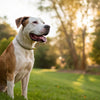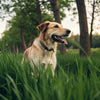Should You Feed a Dog Before or After Exercise? Understanding the Best Practices for Your Furry Friend
- Houndsy
Table of Contents
- Introduction
- The Science Behind Dog Digestion
- Timing Matters: Feeding Before Exercise
- Timing Matters: Feeding After Exercise
- Tailoring the Feeding Schedule to Your Dog's Needs
- Conclusion
- FAQ
Introduction
As dog owners, we often find ourselves asking critical questions about our pets’ health and well-being. One question that frequently arises is, "Should you feed a dog before or after exercise?" This inquiry isn't just a matter of routine; it has significant implications for your dog's health. Did you know that improper timing of meals relative to exercise can lead to digestive issues, discomfort, or even serious conditions like bloat?
When we consider the everyday activities of our beloved pets, the connection between their feeding habits and exercise is paramount. Dogs, much like us, require proper nutrition to support their physical activities. However, how and when we feed them can greatly affect their energy levels, digestion, and overall health.
This blog post aims to shed light on the crucial relationship between feeding schedules and exercise for dogs. We'll explore the science behind digestion, the risks associated with feeding before and after exercise, and provide actionable insights to help you create a balanced routine for your furry friend. By the end, you'll have a comprehensive understanding of how to optimize your dog's feeding and exercise regimen for their health and happiness.
The Science Behind Dog Digestion
Understanding dog digestion is essential for determining the right feeding times. Like humans, dogs have a complex digestive system that breaks down food into nutrients. However, dogs digest food differently based on several factors such as their breed, size, age, and activity level.
How Digestion Works
- Ingestion and Initial Breakdown: When a dog eats, food enters the stomach where it is mixed with gastric juices. This process begins to break down the food into a semi-liquid form known as chyme.
- Intestinal Absorption: The chyme then moves into the small intestine, where most nutrient absorption occurs. This process can take anywhere from 4 to 8 hours, depending on the individual dog's metabolism and the type of food consumed.
- Waste Elimination: Finally, any undigested food and waste products are passed into the large intestine, where water is absorbed, and the remaining material is stored until elimination.
Impact of Exercise on Digestion
Exercise influences how well a dog digests food. During physical activity, blood flow is redirected to the muscles, which means less blood is available for the digestive system. This can slow down digestion, leading to discomfort if a dog exercises too soon after eating.
Moreover, vigorous exercise immediately after eating can increase the risk of gastric dilatation-volvulus (GDV), a potentially life-threatening condition particularly common in large or deep-chested breeds. GDV occurs when the stomach fills with gas and twists, leading to severe bloating and obstruction.
Timing Matters: Feeding Before Exercise
The Risks of Feeding Before Exercise
Feeding your dog immediately before exercise can cause several issues:
- Digestive Discomfort: A full stomach during physical activity can lead to discomfort, nausea, or vomiting. This is particularly true if the meal is heavy or rich in fat.
- Increased Risk of Bloat: Large meals before exercise can lead to bloat, especially in breeds predisposed to this condition. The stomach’s full capacity combined with vigorous movement can trigger GDV.
Recommended Timing
Veterinarians generally recommend waiting at least 1 hour after feeding before engaging in exercise. This allows the dog’s stomach to empty and reduces the risk of discomfort. However, the time may vary based on the dog's size and the intensity of the exercise.
Example Scenario
Imagine you have a Labrador who enjoys a hearty meal before a long walk. If you feed him right before heading out, he may struggle with digestive issues, leading to lethargy or even vomiting during the walk. Instead, by waiting an hour, you allow his body to digest the food properly, making the walk more enjoyable for both of you.
Timing Matters: Feeding After Exercise
The Importance of Post-Exercise Nutrition
After your dog has exercised, it is equally important to consider when to feed them. Proper post-exercise nutrition helps replenish energy stores and aids recovery.
Risks of Feeding Immediately After Exercise
- Digestive Issues: Feeding right after vigorous activity can lead to bloating and discomfort. The body is still focused on recovery from physical exertion, diverting blood flow away from the digestive system.
- Bloat and GDV: Just as with pre-exercise feeding, the risk of GDV increases if a dog eats immediately after intense exercise.
Recommended Timing
Experts suggest waiting at least 30 to 60 minutes after exercise before feeding your dog. This allows their heart rate to return to normal and helps ensure that the digestive system is ready to process food effectively.
Example Scenario
Consider a scenario where your Golden Retriever enjoys a vigorous game of fetch at the park. If you immediately feed him upon returning home, he may experience discomfort or nausea. Allowing him to cool down and relax for at least 30 minutes before feeding helps ensure a pleasant dining experience.
Tailoring the Feeding Schedule to Your Dog's Needs
Individual Considerations
While the general guidelines provide a solid framework, it is essential to tailor your dog's feeding schedule based on their individual needs:
- Breed: Larger breeds, particularly those with deep chests, are at a higher risk for GDV. Extra caution should be taken with their feeding schedules.
- Age: Puppies may require more frequent meals and can sometimes tolerate shorter waiting periods before or after exercise. Conversely, older dogs may need more time to digest food.
- Activity Level: Highly active dogs may require adjustments in both feeding portions and timing to accommodate their energy requirements.
Establishing a Routine
To foster better digestion and health, establish a consistent feeding routine:
- Regular Meal Times: Feed your dog at the same times each day to help regulate their digestive system. This consistency can reduce anxiety around meal times.
- Plan Exercise Around Meals: Schedule walks or playtime based on your dog's feeding times. Aim to walk them before meals or wait a little while after feeding.
- Monitor Water Intake: Always ensure your dog has access to fresh water before and after exercise to maintain hydration.
Conclusion
Understanding whether to feed your dog before or after exercise is vital for their health and well-being. By adhering to the recommended waiting times—at least 1 hour before and 30 to 60 minutes after exercise—you can help prevent digestive issues and ensure your dog receives the nutrition they need to thrive.
As dog lovers, our primary goal is to enhance the daily lives of our furry companions. By establishing a thoughtful feeding schedule, we not only contribute to their physical health but also strengthen our bond with them.
If you're looking for an innovative solution to simplify your dog feeding routine, consider the Houndsy Kibble Dispenser. Its ergonomic design ensures perfect portion control without the mess, making feeding convenient and enjoyable for both you and your pet. Explore the Houndsy Kibble Dispenser here.
FAQ
Q: Can I walk my dog 30 minutes after eating?
A: While some dogs may tolerate it, it’s generally recommended to wait at least 1 hour after feeding before walking to avoid digestive issues.
Q: How long should I wait to feed my dog after exercise?
A: It’s advisable to wait at least 30 to 60 minutes after exercise before providing food to allow for proper digestion.
Q: Why is timing important for feeding and exercise?
A: Proper timing helps prevent digestive discomfort and serious conditions such as bloating or GDV, especially in breeds prone to these issues.
Q: What if my dog doesn’t want to eat after exercise?
A: Monitor their behavior and ensure they are hydrated. If they consistently refuse food, consult your veterinarian.
By considering these factors and following the guidelines, we can enhance our dogs' health and ensure they lead happy, active lives. Remember, your commitment to understanding your dog's needs makes all the difference!












